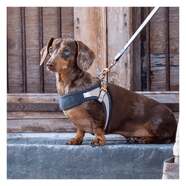Choosing a Pet Harness - Which is the best fit for your pet?
Author: Alicia

Choosing the correct dog harness is critical for your pet's comfort and safety, especially if your dog pulls on the leash. Harnesses come in a variety of styles, each built for a specific function. Here are some important factors to consider while choosing a dog harness:
1. Type of Harness:
- Back-Clip Harness: The leash attachment is located on the rear of the harness. This style is best suited to well-behaved dogs who do not pull excessively. - Read more on how to stop your pup pulling on walks HERE!
- Front-Clip Harness: The leash is attached to the front of the harness, which helps to avoid tugging and gives you greater control.
- Dual-Clip Harness: This style contains leash connection points on both the front and rear, providing versatility in training and control.
2. Size & Fit:
- Choose a harness that is comfortable for your dog. To guarantee proper fit, measure your dog's girth (the broadest area of the chest).
- Because sizes vary across brands, see the manufacturer's sizing guide.
- Make sure the harness is snug but not overly so. Two fingers should fit between the harness and your dog's body.
3. Material
- Look for fabrics that are both long-lasting and breathable. Nylon and polyester are popular materials.
- Padding is available on certain harnesses for increased comfort, which can be good for dogs with sensitive skin.
4. Adjustability
- To guarantee a safe and customised fit, use a harness with adjustable straps.
- Adjustable straps are especially beneficial if your dog is still developing or if you want to use the harness on more than one dog.
5. Ease of Putting on and off
- Consider the design of the harness and how easy it is to put on and take off. Some harnesses have step-in designs, while others go over the head.
6, Refelctive Elements
- If you walk your dog at night, a harness with reflective features might improve visibility and safety.
7. Purpose::
- Choose a harness that meets your individual requirements. There are harnesses built for jogging, trekking, and vehicle riding, for example.
8. Comfort
- Check to see whether the harness chafes or causes pain. Look for cushioning in locations where your dog's skin will come into touch.
9. Maintenance and Cleaning
- Consider how simple it is to maintain the harness. Some can be machine washed, while others may need to be hand washed.
10. Reputation of the Brand:
- Choose a trustworthy brand with a high number of good ratings. High-quality harnesses are more likely to be long-lasting and effective.
Always follow the manufacturer's recommendations for appropriate harness use and upkeep. If you're not sure which style of harness is ideal for your dog, get advice from your veterinarian or an experienced dog trainer or give us a call on 1300 735 995!









